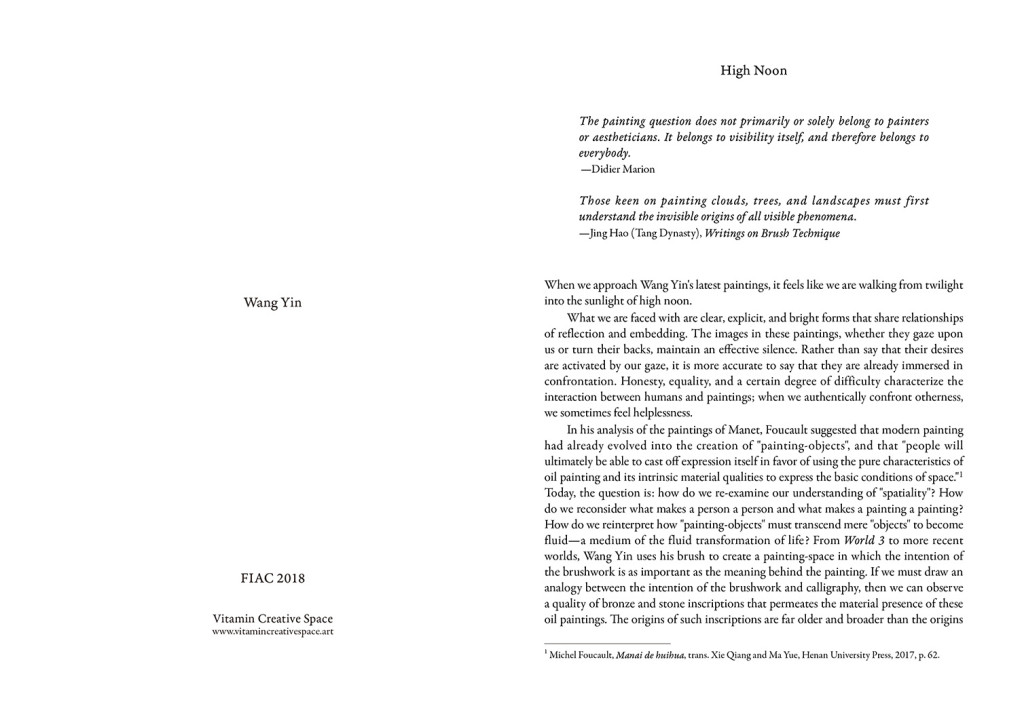
High Noon
The painting question does not primarily or solely belong to painters or aestheticians. It belongs to visibility itself, and therefore belongs to everybody.—Didier Marion
Those keen on painting clouds, trees, and landscapes must first understand the invisible origins of all visible phenomena.—Jing Hao (Tang Dynasty), Writings on Brush Technique
When we approach Wang Yin’s latest paintings, it feels like we are walking from twilight into the sunlight of high noon.
What we are faced with are clear, explicit, and bright forms that share relationships of reflection and embedding. The images in these paintings, whether they gaze upon us or turn their backs, maintain an e ective silence. Rather than say that their desires are activated by our gaze, it is more accurate to say that they are already immersed in confrontation. Honesty, equality, and a certain degree of difficulty characterize the interaction between humans and paintings; when we authentically confront otherness, we sometimes feel helplessness.
In his analysis of the paintings of Manet, Foucault suggested that modern painting had already evolved into the creation of “painting-objects”, and that “people will ultimately be able to cast o expression itself in favor of using the pure characteristics of oil painting and its intrinsic material qualities to express the basic conditions of space.”1 Today, the question is: how do we re-examine our understanding of “spatiality”? How do we reconsider what makes a person a person and what makes a painting a painting? How do we reinterpret how “painting-objects” must transcend mere “objects” to become fluid—a medium of the fluid transformation of life? From World 3 to more recent worlds, Wang Yin uses his brush to create a painting-space in which the intention of the brushwork is as important as the meaning behind the painting. If we must draw an analogy between the intention of the brushwork and calligraphy, then we can observe a quality of bronze and stone inscriptions that permeates the material presence of these oil paintings. e origins of such inscriptions are far older and broader than the origins of oil paints, and they also possess a more existential and atavistic quality.
The brushwork captures time, shape, and energy, but it does not mean to be a “process painting” . It is the plain form of an “appearance”2, coarse and unadorned, but nonetheless, it possesses sensitivity to life experience. It seems to suggest that if the painted world is a kind of existence then each brushstroke should possess formative force. Perhaps all that an artist needs to pursue and achieve is a practice in which each brushstroke is e ective.
Now, we can see how the forms in a painting are mutually dependent, and how this dependence is retained and reinforced through certain fantastic gestures. A person sits in the void, and the mere movements of a single hand allow him to maintain this posture for much longer. The artist, bearing portraits of himself and his family, steps into a river; there, he meets and replaces nameless others. rough repeated outlining, his own portrait becomes unified with those of his family, which in turn become portraits of all humankind. Paintings, constituting a perceptual reality that serves as a unifying genealogy of our species, pile up in the noontime sun, no longer reliant on our gaze to shine.
( Hu Fang )
____________________
1 Michel Foucault, Manai de huihua, trans. Xie Qiang and Ma Yue, Henan University Press, 2017, p. 62.
2 The word used here in the Chinese, 象 (xiang), has multiple connotations including “form,” “image,” “semblance,” and “sign.” It is a key concept in the classic treatises on divination, namely, the Yi Jing (Book of Changes); at the same time, it is also used in Chinese philosophy and poetry to re ect the relationship between linguistic expression and natural entities.
– – –
Vitamin at FIAC 2018
Booth A03
Vernissage:
Wednesday 17th October, 11am to 9pm
Public:
Thursday 18th & Friday 19th October, noon to 8pm
Saturday 20th & Sunday 21st October, noon to 7pm
Contact: mail@vitamincreativespace.art
For more information, please visit: http://www.vitamincreativespace.art
- Booth view at FIAC Paris 2018. Image: Vitamin Archive
- Booth view at FIAC Paris 2018. Image: Vitamin Archive
- Booth view at FIAC Paris 2018. Image: Vitamin Archive
- Booth view at FIAC Paris 2018. Image: Vitamin Archive
- Booth view at FIAC Paris 2018. Image: Vitamin Archive
- Booth view at FIAC Paris 2018. Image: Vitamin Archive
- Booth view at FIAC Paris 2018. Image: Vitamin Archive
- Booth view at FIAC Paris 2018. Image: Vitamin Archive







